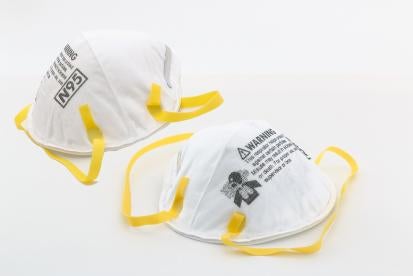One of the biggest questions plaguing employers during the COVID-19 pandemic is whether or not to provide employees with respirators—the holy grail of all PPE at this time. On March 11, 2020, the White House issued a Presidential Memorandum, entitled “Making General Use Respirators Available,” which mandated all necessary efforts by the government and public at large to make respiratory devices available for use by healthcare workers during the COVID-19 pandemic to mitigate against further transmission of the virus. In response, OSHA has issued several forms of temporary enforcement guidance for the Respiratory Protection standard, as well as its April 13, 2020 Interim Enforcement Response Plan for Coronavirus Disease 2019 (COVID-19), and both the healthcare and general industries have scrambled to comply with this exacting standard in the face of extensive shortages.
As we recently discussed here, OSHA issued two enforcement guidance memos on April 3, 2020, regarding issues surrounding the use of respiratory equipment. The first memorandum discusses the use of respiratory protection and the N95 mask shortage due to COVID-19, specifically outlining enforcement discretion to permit the extended use and reuse of respirators, as well as the use of respirators that are past their manufacturer’s recommended shelf life—when following the directions set forth in the memorandum (i.e., attempting to obtain other NIOSH-approved respirators and using all other feasible engineering controls) and when used as recommended by the CDC. The reasoning behind the memorandum is the sad fact that the pandemic has limited the availability for N95 filtering facepiece respirators to only workers in the healthcare and emergency response fields (and even then there are not enough respirators to go around). The second memorandum provides similar guidance on the use of respiratory protection equipment certified under the standards of other countries or jurisdictions during the COVID-19 pandemic, if the methods set forth in the first memoranda are unavailable. Both memoranda explicitly explain their application to both (1) healthcare personnel exposed to actual and potential COVID-19 patients, as well as (2) workers exposed to other respiratory hazards due to the shortage of respirators resulting from the COVID-19 pandemic response.
On April 8, 2020, OSHA issued further guidance and announced the expansion of temporary guidance provided in a March 14, 2020 memorandum regarding supply shortages of N95 masks or other filtering facepiece respirators (FFRs) due to the COVID-19 pandemic. The memorandum expands application of mandatory fit-testing requirements in the March 14 memorandum beyond healthcare to all workplaces covered by OSHA—where there is required use of respirators—and explains that “OSHA field offices will exercise enforcement discretion concerning the annual fit-testing requirements, as long as employers have made good-faith efforts to comply with the requirements of the Respiratory Protection standard and to follow the steps outlined in the March 14, 2020 memorandum.”
Notably, all three memoranda outline some version of this statement: “Due to the impact on workplace conditions caused by limited supplies of N95 FFRs, all employers should reassess their engineering controls, work practices, and administrative controls to identify any changes they can make to decrease the need for N95 respirators. Employers should, for example, consider whether it is possible to increase the use of wet methods or portable local exhaust systems or to move operations outdoors. In some instances, an employer may also consider taking steps to temporarily suspend certain non-essential operations.” OSHA also clarified that “[a]ll employers whose employees are required to use or are permitted voluntary use of respiratory protection must continue to manage their respiratory protection programs (RPPs) in accordance with the OSHA respirator standard, and should pay close attention to shortages of N95s during the COVID-19 pandemic. Paragraph (d)(1)(iii) in section 1910.134 requires such employers to identify and evaluate respiratory hazards in the workplace, and paragraph (c)(1) requires employers to develop and implement written RPPs with worksite-specific procedures and to update their written programs as necessary to reflect changes in workplace conditions that affect respirator use.” OSHA confirmed this fact in its April 13, 2020 Interim Enforcement Response Plan, where it again focused on healthcare and emergency response job tasks with “high” and “very high” occupational exposure risk to COVID-19.
So who should be provided respirators in the first place then? OSHA has not yet put forth any guidance saying that it will require (or even recommend, consistent with CDC guidance for the general public) NIOSH-approved respiratory protection in the typical working environment, except for employees working within 6 feet of patients “known to be, or suspected of being, infected with SARS-CoV-2 and those performing aerosol-generating procedures.” The agency has also clarified that the use of PPE, including respiratory protection, should not take the place of other prevention strategies.
However, whether respiratory protection is required is still a case-by-case analysis, the outcome of which will be dependent on each employer’s internal hazard assessment and the risk category within which the employer’s workers fall (as described in OSHA’s guidance). Only for high risk and very high risk positions does OSHA recommend the use of respiratory protection, including NIOSH-approved N95 devices, as well as face shields or goggles—in accordance with CDC guidance for hospital preparedness. For medium risk workplaces, the guidance notes that situations requiring employers to use respirators are rare. And for lower risk workplaces, OSHA does not even recommend additional PPE, let along respirators. Instead, the agency directs that “[w]orkers should continue to use the PPE, if any, that they would ordinarily use for other job tasks.” Therefore, employers falling into the latter two categories that want to provide respiratory protection may be stuck between a rock and a hard place until supply levels increase and agency guidance expands.
That said, OSHA recognizes the difficulties at hand and has clarified that its inspectors will be given specific enforcement discretion when enforcing the Respiratory Protection standard during the COVID-19 outbreak. In exercising this discretion, inspectors are instructed to refer to OSHA’s guidance outlined herein, to continue to check for additional or modified guidance, and to always assess “whether the employer is making a good-faith effort to provide and ensure workers use the most appropriate respiratory protection available for exposures to SARS-CoV-2.” Per OSHA’s Interim Enforcement Response Plan, assessing good-faith efforts will be accomplished by the following:
-
Implementing the hierarchy of controls in an effort first to eliminate workplace hazards, then using engineering controls, administrative controls, and safe work practices to prevent worker exposures to respiratory hazards;
-
Prioritizing efforts to acquire and use equipment according to OSHA’s guidance memorandum above;
-
Performing a user seal check each time an employee dons a respirator, regardless of whether it is a NIOSH-certified device or not, and do not use a respirator on which they cannot perform a successful user seal check; and
-
Training workers to understand proper usage, maintenance, sanitation, and storage of respirators and other PPE.
In other words, it is hard to get respirators in the first place, even for healthcare and emergency workers falling into the high and very high risk categories. So, employers must implement comprehensive backup plans involving the use of engineering controls, administrative controls, safe work practices, and other appropriate PPE. However, if respirators are available for your workers, and they need and are provided respirators for their particular position, they must be used in the context of a comprehensive respiratory protection program that meets the requirements of OSHA’s Respiratory Protection standard (29 CFR 1910.134), at least to the greatest extent possible, including the requirements for medical exams, fit testing, and training.





 i
i


